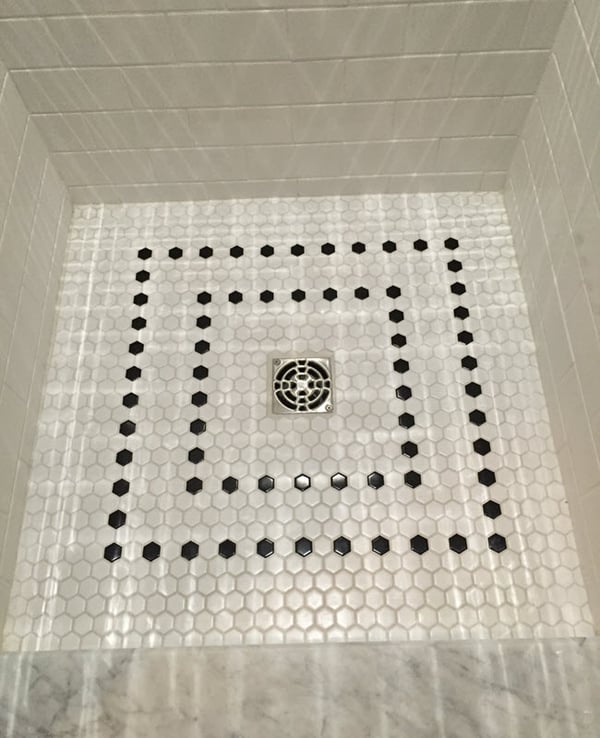
What does it take to ensure that you have a quality tile installation? Based on our experience, knowledge, and work with the Tile Council of North America (TCNA) Handbook, we have identified ten requirements.
Note that these aren't all industry requirements. However, they all contribute to a quality tile installation.
Here they are.
CTEF's Top Ten Requirements for a High-Quality Tile Installation
1. Hire Only Skilled Tile Installers
Only well-trained and experienced tile installers can produce installations of the highest quality which provide long-lasting beauty and functionality. Realize that tile isn't just a decorative layer in a home or commercial building. It must meet specific standards so it performs as it should over time.
To differentiate this quality-oriented tile installer from others in the field, consider hiring a CTEF Certified Tile Installer (CTI). CTIs have proven that they have the knowledge and skills that meet industry standards and best practices.
>> See Need Tile Setters? Focus On Qualified Labor
>> See Tile Installation Certification in Action
>> See What's the Certified Tile Installer Program?

2. Incorporate Movement Accommodation Joints in the Tile Installation
All tile installations, both residential and commercial, will move with temperature and humidity variations.
To accommodate this expansion and contraction activity, the use of expansion joints per the TCNA Handbook for Ceramic, Glass, and Stone Tile Installation method EJ171 are essential and required in all tile work. As stated in the Handbook,
“The design professional or engineer shall show the specific locations and details of movement joints on project drawings.”
Be certain that all parties involved in the project including the architect, the specifier, the designer, the salesperson, and the tile installer know and understand the critical use and placement of expansion joints.
>> See Why Do You Need Expansion Joints When Installing Tile?
3. Work Only With Premium Materials to Install Tile
The use of premium quality bonding materials is money well spent.
Merriam-Webster defines premium as,
“of exceptional quality or amount; also, higher priced.”
Exceptional quality comes at a price. The components added to these materials provide enhanced characteristics that affect both function and durability. For instance, saving a couple of pennies per square foot on a conventional and less expensive thin set mortar rather than using a feature-laden large and heavy tile mortar is a foolish idea.
Tile Industry experts agree this is one of the easiest insurance policies for preventing installation problems. All types of setting materials are available in various performance levels to meet the requirements of the job.
Contact the setting material manufacturer for products with the specific characteristics and performance levels necessary for success. Always pay attention to manufacturer instructions.
Additionally, always read and follow the manufacturer’s guidelines printed on the bag of any product since the mixing requirements and/or application may be different compared to materials used in the past.
>> See Do You Ignore Grout Manufacturer Directions?
4. Confirm that Tile Installation Surfaces are Flat
In order to provide a flat ceramic or stone tile installation, carpenters, masons, concrete finishers and other trades must meet the tile industry standards for flatness tolerances.
If substandard surfaces are encountered, they must be corrected before installation begins. Otherwise, you will not have a quality tile installation: the quality of the installation will be compromised.
>> See A Flat Floor vs. a Level Floor: What's the Difference?
>> See Is Your Floor or Wall Flat Enough for Large Format Tile?
5. Verify that the Tile Installation Surface is Rigid
Ceramic tile installations require a stiff or rigid surface. In some cases, installations, including natural stone, may require additional subflooring, wall studs, or bracing. Realize that the substrate for natural stone tile installations must be twice as rigid as that for a ceramic or porcelain tile installation.
Tile contractors should always follow the applicable recommendations of the TCNA Handbook for Ceramic, Glass, and Stone Tile Installation, the ANSI (American National Specifications for the Installation of Ceramic Tile) as well as the recommendations of the manufacturer’s products being used in the project.
>> See Tile Installation Resources
>> See The TCNA Handbook for Ceramic, Glass, and Stone Tile Installation
6. Minimum Mortar Coverage Must Be Provided
Tile industry standards require minimum mortar coverage of 80% in dry areas and 95% in wet (showers) or exterior areas. Natural stone tile installations require 95% coverage in all applications.
This refers to the contact area of the bonding material (thin-bed mortars, large and heavy tile mortars, or epoxy adhesives) with both the back of the tile and the surface being tiled.
>> See How to Correctly Trowel Mortar When Installing Tile?
7. Ensure that Tile Site Conditions Are Controlled
Jobsite conditions can have a serious impact on the success or failure of a tile installation.
ANSI A108.02 section 4.1 (excerpted) states,
“Installation work shall not proceed until satisfactory conditions are provided.”
Many products used in tile installations require that the temperature be maintained within a specific range and duration. Be certain to follow the manufacturer’s guidelines to ensure a long-lasting installation.
In addition, insist on a mockup so you can view a sample of the actual installation which includes items such as tile color/variation, grout joint size/color, and gauge the variation from tile to tile which ensures that the final installation meets your expectations.
>> See Why a Tile Installation Mockup is Really Necessary
8. Use Only the Correct Tile Installation Methods and Materials
Not all installation methods and/or materials are suitable for all applications. Be certain that your contractor will use the TCNA Handbook method rated for the intended application or a method that is recommended, fully specified, and warranted by the product manufacturer.
Research manufacturer’s websites to determine suitability, application recommendations, and product warranty information.
Review the manufacturer’s product data sheets and recommendations for the tile, backer board, bonding materials, membranes, and grout that will be used on the job.
Just because a product is available doesn’t mean that it is appropriate for a given installation.
>> See ANSI Standards: A Tile Installer's Best Friend!
9. Allow for Adequate Cure Time
Allow a tile installation to cure sufficiently per the manufacturer's recommendations before exposing it to moisture, traffic, temperature changes, or overlaying products. Otherwise, it will not perform as a quality tile installation.
The amount of time required will vary based on site conditions and the specific materials being used.
10. Make Use of Crack Isolation Membranes as Needed
Cracks in concrete and other areas of movement should be treated with a crack isolation membrane (ANSI A118.12) to help eliminate cracked tiles. As mentioned previously, the addition of a crack isolation membrane can be cheap insurance that provides a beautiful and long-lasting installation.
Check with the membrane manufacturer for specific use and application recommendations.

Questions From Readers About Quality Tile Installation Requirements
Readers asked the following two questions.
Verifying Materials and Shuffling Stone
Lynne Miyake comments:
Also, it is important to have the tile installer verify the material to assure that material is square, and flat, size and color are accurate, and they shuffle material (especially stone) prior to installing.
Scott responds:
The tile installer is not required to make these assessments, however, it would be wise for the installer to verify with the end user that the provided materials will meet the owner’s expectations. The use of a mockup (included in # 7 above) will serve this purpose.
As to the shuffling or blending of the tiles being installed, the Ceramic Tile Selections Guide of the TCNA Handbook states:
“Although checking the range of color and textures for V3 (Moderately variant) and V4 (Substantially variant) tile is specifically recommended, all of the categories above (V0 [Very uniform] to V4 [Substantially variant]) have some range and should be checked and generally installed from several boxes in a random fashion to avoid aesthetic issues.”
The Natural Stone Tile Selection and Installation Guide of the TCNA Handbook states:
“For viewing and installation, it is recommended that the material be blended from multiple packaging units to distribute the variation throughout the project and to avoid a blocking effect, where an area of one shade is distinctly bordered or surrounded by a different shade.”
Tile Installation Requirements in Washington State
Myrn Stewart asks:
What are the requirements for a tile installer in WA State? Do they have to be supervised by a licensed contractor? Can they work independently if they have some sort of "certification"? If they are working under a general contractor - is that contractor responsible for the finished product?
Scott replies:
I am not familiar with the requirements in the state of Washington, but the requirements (if they exist) can vary dramatically and would be individual to that state. It may be best to contact the licensing board in your area to determine any and all requirements before the job begins.
Regarding the certification of tile installers, we would strongly recommend that you find, interview, and hire a Certified Tile Installer (CTI) for your project. The installers included in this program of the Ceramic Tile Education Foundation (CTEF) have, through extensive testing, proven that they possess the knowledge and skills which meet and exceed the tile industry standards and best practices.
>> Locate a CTI
Regarding your last question about who is responsible for the finished product, this should be clearly stated in the contractual agreement between the owner and the general contractor. However, if the owner is working directly with the tile contractor, the contract documents should likewise be clear on responsibilities and expectations.
What Requirements Would You Add?
What would you add to this list of requirements for a high-quality tile installation? Let us know in the comments.
Thank you for reading and please tell your friends about these recommendations before they begin their next project.
Note: This article was originally published on July 12, 2016, and has been updated.
